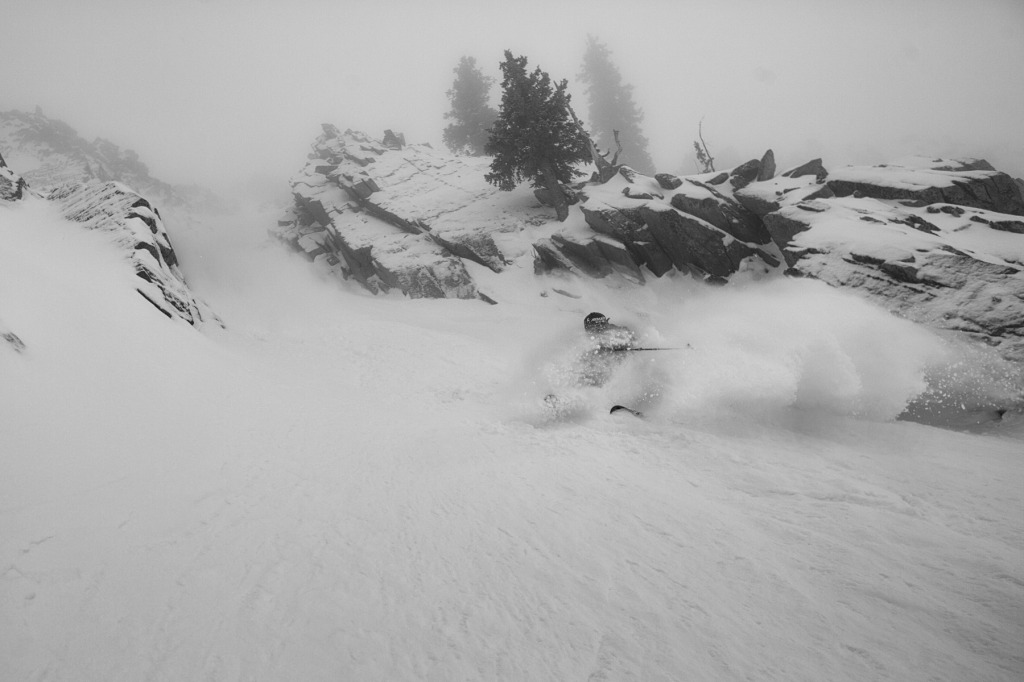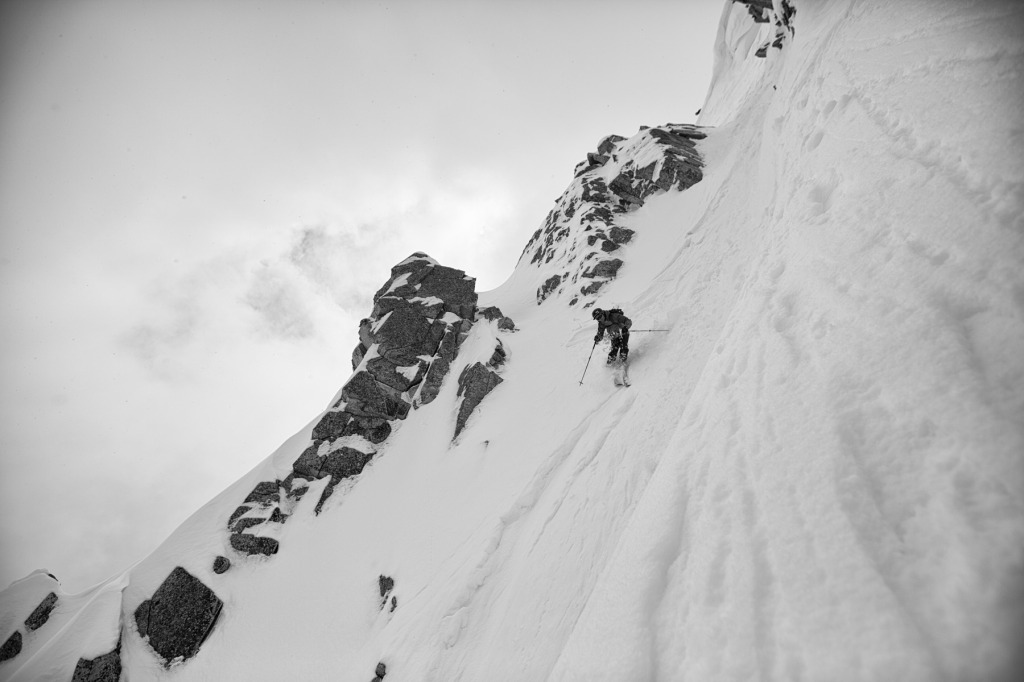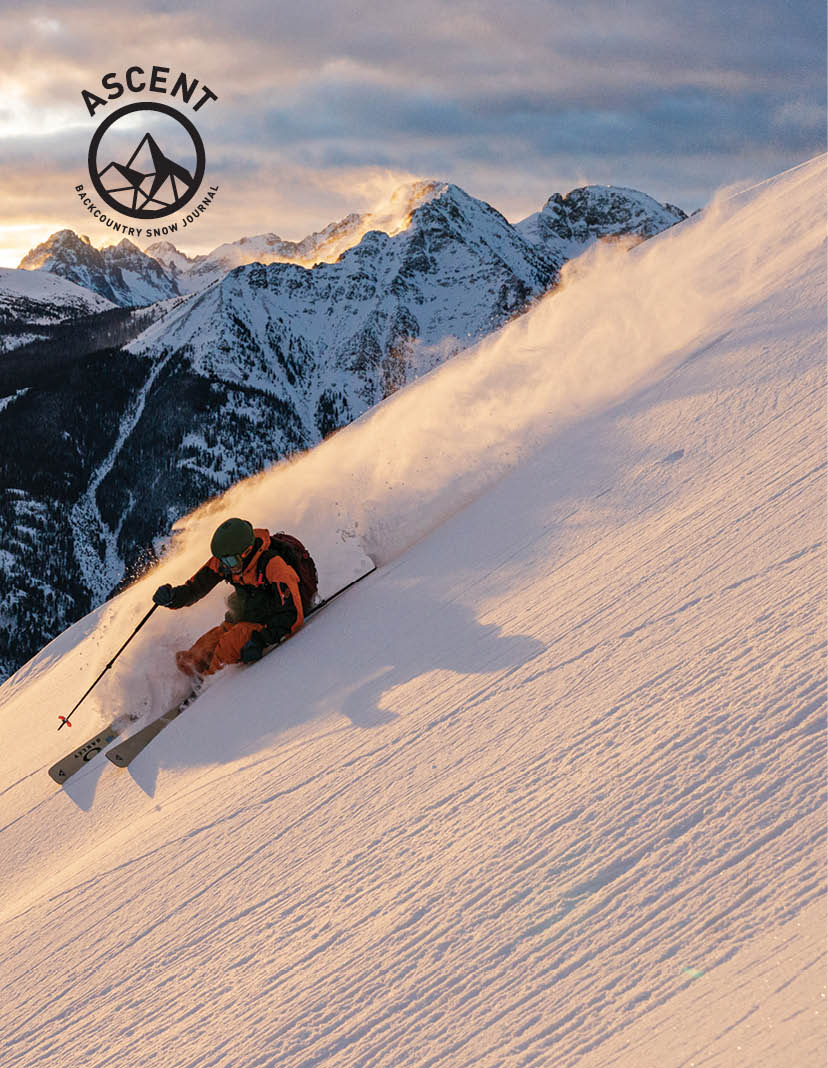Wolverine Cirque isn’t normally my idea of adventure skiing. It’s easy to access and escape, popular and commonly crowded, close to a world-class ski area, and short. I don’t ski there. But it also features traits of great backcountry skiing: it is above 10,000 feet in elevation, west-, north-, and east-facing, steep and sheltered enough to hold powder, and broken by numerous relatively narrow couloirs. Like many of us, I’m an enthusiast of both adventure and good skiing. How can I reconcile that with Wolverine Cirque, which seemingly presents a clash?
On April 4, 2014, Jim Harris called me with an idea—an idea with the potential to turn a day in Wolverine Cirque into a physical challenge with a dubious outcome. An adventure.
“Let’s ski all of the lines in Wolverine in a day.”
Okay, let’s.
“It’s been done before. But who cares?”
Not me.
“It’s probably around 10,000 vertical feet of climbing.”
Sounds hard.
“It took Noah 8 hours.”
And he’s strong.
“8:00AM at the Park-n-Ride?”
Ugh. I’d prefer 9:00AM. But I’ll be there.
Five of us started from Little Cottonwood Canyon’s Grizzly Gulch Trailhead, a popular disaster of ill-advised folks wandering into avalanche terrain for the first time. I understand that situation, because I was one of them in 2008, as I snowshoed up to build a jump over the 80+ feet of Pyramid Gap’s famed freestyle terrain. It was my first time using skis more than ten minutes from hot chocolate. I had a borrowed beacon that I didn’t know how to turn on, a skateboard backpack with skis chaotically attached, and an Overconfident College Friend from Out West (OCFOW). I didn’t even know what I didn’t know about avalanche mitigation—surprisingly, it somehow wasn’t a concern while growing up in Ohio. When my OCFOW said I was safe, I didn’t know that wasn’t necessarily true. Seven winters later, I have judiciously less confident and more educated partners, my own beacon, and a backpack with ski straps.
That same year, on the recommendation of yet another OCFOW, I also bought the unmatched 1998 Wasatch guidebook The Chuting Gallery, by local author and celebrated ski mountaineer Andrew McLean. The book, considered by many steep skiers to be the Bible of the Wasatch, references 16 named couloirs in Wolverine Cirque. Jim and I had each ridden a few of them over the years, but the majority was new to us. From west to east, our group started skiing them under hot morning sunshine. Our only concerns were warming snow and foot sweat.
As the day progressed, personal commitments stole friends from us between laps. By 2:00PM, at the base of our eighth couloir, Jim and I were sipping tea, together but alone, watching Ian Provo leave us to finish our day with no company but each other’s. The sun was falling toward the Oquirrh Mountains in the west, and the late morning’s snowfall had intensified, leaving each couloir deeper than the previous. On paper, we were halfway done; staring through the heavy snow and thick clouds at the longer, taller west-facing chutes, we were not.
We emptied our backpacks of everything except those safety items that were vital for a single run, since each took only 25-40 minutes. We ate and hydrated at our cache, which rotated counter-clockwise around the base of the cirque with every handful of runs. Given the hard snowfall, our gear was as minimal and light as safely possible, keeping us from feeling unnecessarily burdened. We stayed close together, breaking trail and pulling the other when fatigue began to show itself. The unsettled weather became bad enough to doubt the day’s mission, but never bad enough to bail.
We were able use skins as our only means of ascension; with such deep snow, we did not need to bootpack once. Much of the day was spent breaking identical trail through powder, as the snowfall and wind often re-filled our skin track from the previous climb. Jim is an accomplished photographer, and in the morning committed to taking at least one photo of every run. Staying true to his word, he never failed to drop in before me, nab a few untouched powder turns, and quickly set up his camera. Clearly, Jim is not an OCFOW.
Although only 500 feet long, Roman’s is rated as the most technical couloir in the cirque. Because only a few inches of snow had accumulated by the time we were peering through our ski tips and into its 50-degree entrance, the rocks were covered just enough to be invisible to our eyes. They were not invisible to our ski bases. A quick stone grind led to a steep shot of powder, but, more importantly, to the realization that we were skiing Wolverine Cirque in true, midwinter, powder conditions.
We used Granny’s as our ascent track for the first 11 laps. For the next five laps, we skinned up the chute around the corner from Sushi Chute (unnamed in the book) and repeatedly broke trail up it and the east Wolverine ridgeline—a perfect viewpoint for our western descents, had visibility presented them. The snowfall never relented.
By the time we’d skied the north-facing lines and were working our way into the west-facing chutes, dark clouds had settled into the basin. Blasting winds, heavy snowfall, and whiteout conditions tattered and tested our resolve. And although challenging, it was also rewarding: we were skiing exclusively powder. The thick cloud cover veiled the setting sun until we realized the clouds weren’t growing continually thicker, it was just becoming dark.
Skiing is captivating. There is no obvious reason why we stayed out there all day. No coach was pushing us to keep going after lap number seven, no sponsor was pressing us on lap 11, and there wasn’t a crowd cheering for us at the bottom of lap 16. No one even knew that we were out there. Low visibility wasn’t conducive to classic photography; wind and snow sucked spare energy out of us; we watched other skiers come and go at their leisure; and Jim had his girlfriend (now fiancé) sitting at home, waiting for him. He was late for an affair that evening, I had to wake up early the next morning, and we were exhausted. We live for this stuff.
The 1000-foot-long Scythe drops from the summit of 10,795-foot Mount Wolverine. Following the obvious left dogleg, the snow became discernibly deeper as we reached the apron, taking a fast northward turn toward another couloir awaiting a fresh skintrack. We pole-pushed along the bases of the next five chutes, limiting the amount of skinning and, hopefully, speeding the process. Three laps later, the day’s sky-borne bounty was evident in Scratch n’ Sniff, billowing its way up the bottom of our jackets, hems loosened to let the climbs’ sweat escape. For us skiers, it’s a rare and striking day when, eight hours after the first, runs are only becoming deeper with time—an experience almost exclusive to days spent riding beyond the confines and crowds of ski resorts.
After more than 10 hours, I looked back at Jim on the skintrack and said, fully aware of the irony, “ After so many transitions and heavy snowfall, I can’t believe we haven’t had any skin failures. Oops, did I just say that?” Less than five minutes later, Jim growled at me after stepping right out of his failed skin on our way back up to Twin Lakes Pass. The sun had set, and along with shared familiarity of Grizzly Gulch, there was just enough ambient city light pollution to guide us back to the car with a little headlamp help.
Instead of presenting a clash between good skiing and adventure, Wolverine Cirque offered a combination. A physical challenge with a dubious outcome in ever-deepening snow? That’s an adventure. An adventure that just happens to be in optimal ski conditions, even if it’s 40 minutes of skinning from the parking lot.
I bought McLean’s guidebook online during an especially slow evening at the Westminster College climbing wall, where I worked as a rock-climbing instructor, during my sophomore year. It was 2008, and when I received it in the mail, it was hand signed by the man himself, “Ski ‘em all!” I don’t think I’m ever going to achieve that, but at least I skied all of them on page 64.
A small, private, liberal arts college brought Brody to Salt Lake City. The mountains and their butt-kickings keep him around.
* * *
Sidebar
To easily reach Wolverine Cirque, start from the Grizzly Gulch trailhead at the (winter) end of Little Cottonwood Canyon’s Highway 210. From there, follow the inevitably plentiful skin tracks up the Summer Road before heading left (north) past the highest homes and into Grizzly Gulch proper. Follow the cat track east to Twin Lakes Pass, where your right (south) turn will have you on the ridge to the summit of Patsy Marley. Standing there, you’ll be on the far skier’s left (NW) of the cirque, and all of the couloirs will be laid out to your South. Beware that this specific approach brings you to the top of the couloirs, and does not allow you to climb your first before you ski it. It takes less than 20 minutes to skin from Patsy Marley to Mount Wolverine, the SE corner of the cirque. From one of these summits, you can reach every couloir.
Tips & Tricks
Given essential avalanche safety training, nearly any upper caliber of backcountry skier or splitboarder can find a chute to their liking, and should be able to climb and ski two or three in a morning session. Experienced backcountry riders with decent fitness and ski/hike transition efficiency should be able to knock out five to 10. Or, better yet, ski all 16.
I am a very weight-conscious skier, and a thermos rarely finds itself in my pack. But for a long day that allows a gear cache, it was revitalizing to have a bite of food and a cup of hot tea while the snow stacked up between laps. Bring a stuff sack for extra food and layers, and store it beneath a safe and sheltered rock at the bottom of Granny Chute, which you’ll likely use as your primary ascent route. You only need to carry the heavier items up the easy Grizzly Gulch trail, thus it is debatably appropriate to treat yourself to a little luxury.
















